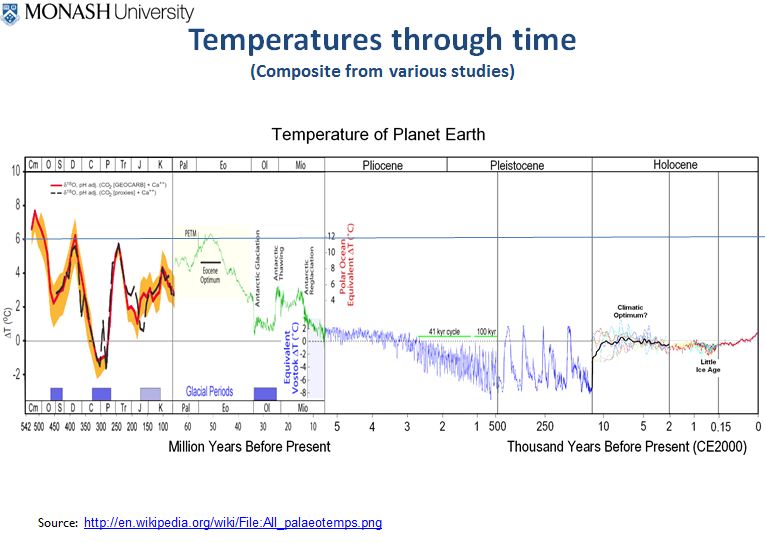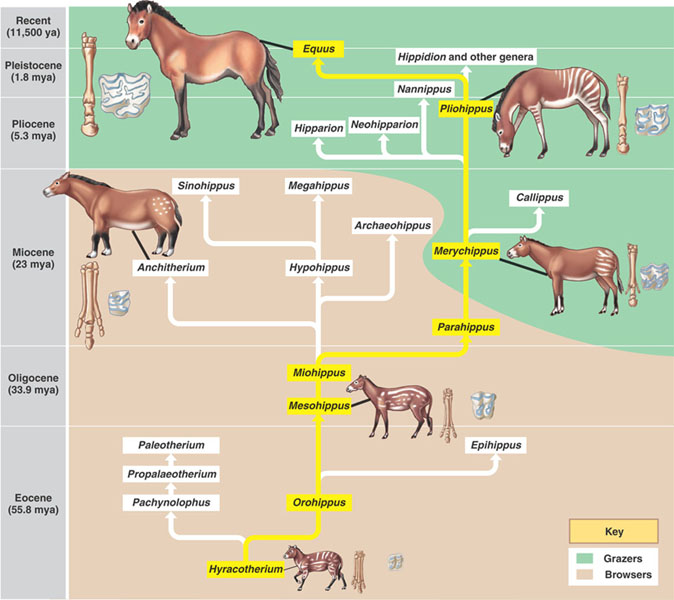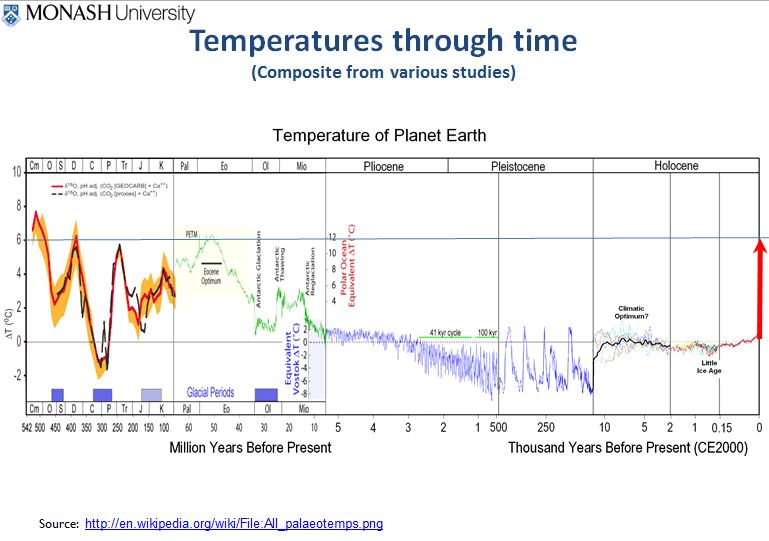Last week I gave a presentation to the Master Builder’s Association on climate change and its projected impacts. One of the most difficult things to convey in such talks is context – what does 2, 3 or 4°C degrees of warming above pre-industrial temperatures actually mean? Richard Jones Executive Director of the International Energy Agency said in April, for example, that we are on track for something like 6°C:
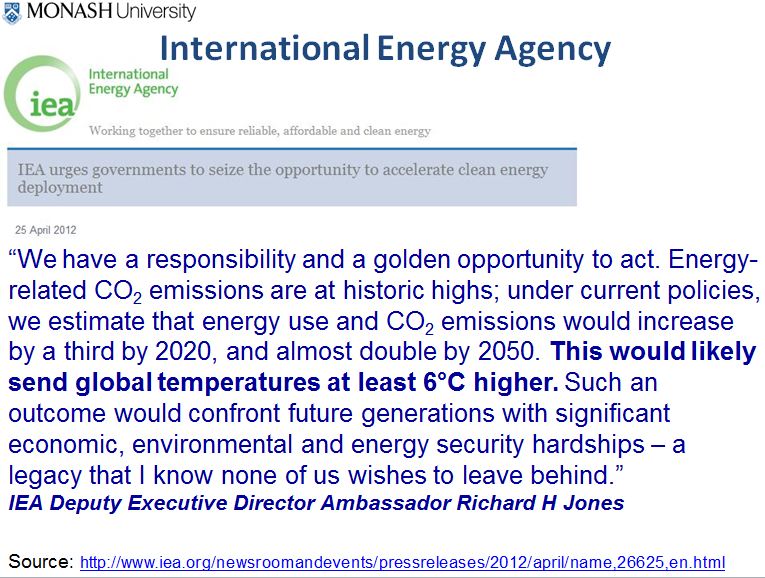 Now this is the International Energy Agency talking – not Greenpeace. In June Rex Tillerson, the CEO of ExxonMobil was interviewed, and this is some of what he had to say:
Now this is the International Energy Agency talking – not Greenpeace. In June Rex Tillerson, the CEO of ExxonMobil was interviewed, and this is some of what he had to say:
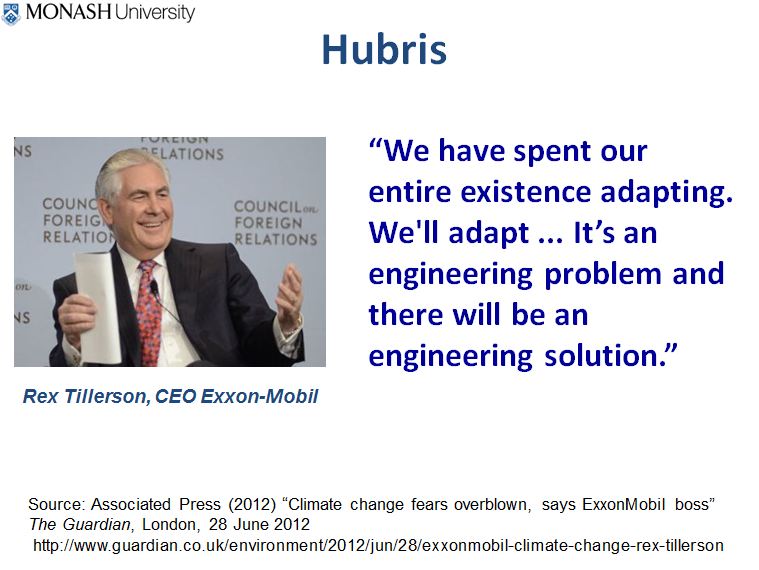 Hmmm. We’ll adapt? OK so what does 6°C warming in historical context look like? Well, as a former geologist, I’ve always been fascinated by paleoclimatology (not that I knew that word when I was six and was learning the names of all the dinosaurs). The chart below, which is a composite from various studies published in the scientific literature, gives some perspective, running from 542 million years ago, to today:
Hmmm. We’ll adapt? OK so what does 6°C warming in historical context look like? Well, as a former geologist, I’ve always been fascinated by paleoclimatology (not that I knew that word when I was six and was learning the names of all the dinosaurs). The chart below, which is a composite from various studies published in the scientific literature, gives some perspective, running from 542 million years ago, to today:
If you’re wondering where the dinosaurs were, they existed from roughly the Triassic (Tr), through the Jurassic (J) and into the Cretaceous (K) periods, 250 to 65 million years ago. Then we come to the Paleocene (Pal) and Eocene (Eo) epochs. Around 50 million years ago the earth experienced something called the ‘Eocene Optimum‘ in which temperatures were around 6°C warmer and there was little or no ice on the planet. As you can see from the chart – the Earth took several million years to reach this temperature and tens of millions to cool back to current levels. And of course we had the oscillations of the ice ages along the way, with temperatures a few degrees cooler than now at various times. 50 million years is a long time of course, so it may help to take a look at how horses evolved over that period:
So 50 million years ago, the last time we had temperatures 6°C warmer than now, horses as we know them didn’t exist – just little guys we’ve called Hyracotheriums (sometimes called Eohippus) that stood only 20 cm tall. So what would 6°C warming look like in historical context? Well, like this:
We’re not talking then, about going back to the days of plucking grapes off vines in merry olde England during the medieval warm period. No, 6°C in less than 100 years is essentially a vertical line straight up, to temperatures that haven’t existed on Earth since the ancestors of horses were the size of small dogs and humans were a distant dream. As far as we know, the Earth has never experienced such a massive near-instantaneous temperature rise. That’s what Mr Tillerson smilingly assures us that we and the planet’s ecosystems can adapt to. As a result of the views of powerful interests like Tillerson’s and the hordes of other deniers, most governments are treating climate change, if at all, like a moderately significant economic reform – like tariff reform or floating the dollar, rather than as a national and global emergency. As Robert Manne wrote recently in his superb but chilling article A Dark Victory: How vested interests defeated climate science: “This is a victory that subsequent generations cursing ours may look upon as perhaps the darkest in the history of humankind.”
Well I for one am not giving up yet. I think our children, the poor and our planet are worth fighting for. Please give your support to one of the many organisations striving for urgent action on climate change. And maybe next time you hear someone saying that we’ll just adapt or that taking urgent action on climate change is ‘extremism’ – show them this chart.

